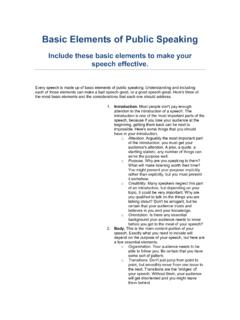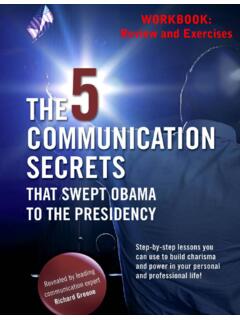Transcription of Repeating Words in Spontaneous Speech
1 COGNITIVE PSYCHOLOGY37,201 242 (1998)ARTICLE Words in Spontaneous SpeechHerbert H. Clark and Thomas WasowStanford UniversitySpeakers often repeat the first word of major constituents, as in, I uh I wouldn tbe surprised at that. Repeats like this divide into four stages: an initial commitmentto the constituent (with I ); the suspension of Speech ; a hiatus in speaking (filledwith uh ); and a restart of the constituent ( I wouldn t .. ). An analysis of allrepeated articles and pronouns in two large corpora of Spontaneous Speech showsthat the four stages reflect different principles.
2 Speakers are more likely to makea premature commitment, immediately suspending their Speech , as both the localconstituent and the constituent containing it become more complex. They plan someof these suspensions from the start as preliminary commitments to what they areabout to say. And they are more likely to restart a constituent the more their stoppinghas disrupted its delivery. We argue that the principles governing these stages aregeneral and not specific to repeats. 1998 Academic PressSpontaneous Speech is filled with disfluencies unwanted pauses, elon-gated segments, fillers (such asuhandum), editing expressions (such asImeanandyou know), word fragments, self-corrections, and repeated disfluencies seem to reflect planning problems.
3 When speakers cannotformulate an entire utterance at once, they may suspend their Speech andintroduce a pause or filler before going on. And when speakers change theirminds about what they are saying, they may suspend their Speech and thenadd to, delete, or replace Words they have already produced. Disfluencieshave long been used as evidence of planning ( , Clark, 1996; Goldman-Eisler, 1968; Levelt, 1983, 1989; Maclay & Osgood, 1959; Schegloff, Jeffer-son, & Sacks, 1977).In this paper we investigate the origins of repeated Words .
4 Consider anutterance in which Reynard is speaking to Sam:This research was supported by NSF Grants SBR-9309612 and IRI-9314967 and by thank Erica Don, Yafeng Li, and Jon Lindsay for their help in the analyses and Eve , Gary S. Dell, Jean E. Fox Tree, Antje S. Meyer, Padraig O Seaghdha, Elizabeth , and several unnamed reviewers for their correspondence and reprint requests to Herbert H. Clark, Department of Psychol-ogy, Stanford University, Stanford, CA 94305-2130, or Thomas Wasow, Department of Lin-guistics, Stanford University, Stanford, CA $ 1998 by Academic PressAll rights of reproduction in any form AND WASOW(1) yes, I uh I wouldn t be surprised at that, I really wouldn t, ( ).
5 1 After Reynard produces I uh, he could have continued wouldn t be sur-prised at that, but he repeatsIfirst. The puzzle is why. RepeatingItakesextra time and effort. It is redundant. And by most accounts it ought to makethe utterance harder to understand, since there is no English clause of theformI I wouldn t be surprised at seem to have good reasonsfornotrepeating Words , yet they often do. Repeated Words are one of themost common disfluencies in Spontaneous Speech (Deese, 1984; Maclay &Osgood, 1959).Disfluencies have been viewed from two perspectives.
6 In one tradition,they are treated mainly as the outcome of processes that, once initiated, runoff without intervention. We will call thesepureprocesses. In (1), for exam-ple, Reynard might have repeatedIbecause it was the most highly activatedword when he resumed speaking afteruh,and he couldn t help but produceit. Accounts in the process tradition tend to eschew appeals to intentions,purposes, or monitoring. In a second tradition, disfluencies are viewedmainly as the result of certainstrategies processes with options under aperson s control.
7 In (1), Reynard might have repeatedIbecause, in the wordsof Maclay and Osgood (1959), he wanted to produce some kind of signal([m, er], or perhaps a repetition of the immediately preceding unit) whichsays, in effect, I m still in control don t interrupt me! (p. 59). Accountsin the strategy tradition generally do appeal to intentions, purposes, and two traditions, however, offer complementary, not conflicting per-spectives on disfluencies. Most pure processes are deployed in the serviceof strategies ultimately, what speakers are trying to do by speaking.
8 At thesame time, no strategy can work without deploying pure processes. The con-trast partly reflects the evidence appealed to. Pure processes have generallybeen studied in controlled laboratory Speech , where speakers have few ifany options. Strategies have generally been suggested for spontaneousspeech, where speakers have a plethora of options and the opportunities fortaking them. We will focus on strategies while taking note of the relevantpure this paper we propose acommit-and-restore modelof repeated first lay out the model, an extension of the model of repairs from Levelt(1983, 1989), and describe three hypotheses that follow from it.
9 We thentest the hypotheses as they apply to English articles and personal of the examples we cite are from one of two corpora, described later. Those from theLondon-Lund (LL) corpus (Svartvik & Quirk, 1980) are identified by the conversation ( )and line (278) they came from. In these examples, the end of a tone unit is marked by acomma (,), a brief pause (of one light foot) is marked by a period (.), a unit pause (ofone stress unit) is marked by a hyphen (-), and elongated vowels are marked by a colon (:).
10 The rest of the examples come from the switchboard (SW) Words IN Spontaneous SPEECH203 The evidence we use comes from two large corpora of Spontaneous Speech ,one American and one MODEL OF REPEATED WORDSR epeating a word is often treated as an unanalyzable event ( , Deese,1984; Holmes, 1988), but is really a sequence of processes, each with itsown options and limitations (Clark, 1996; Levelt, 1983). Here we dividerepeats into four I: Initial CommitmentWhen speakers produce a word, they are ordinarily committing themselvesto one or more constituents containing that word and to meaning somethingby them.



















